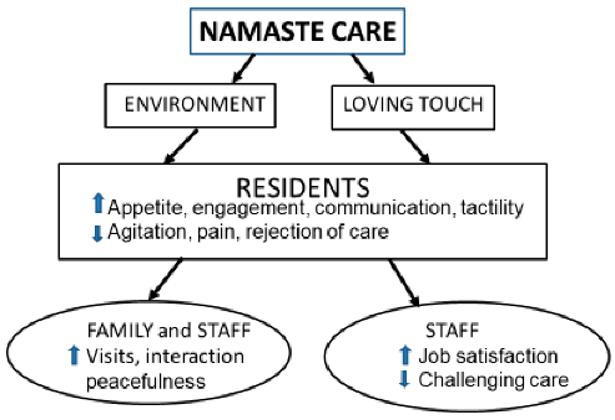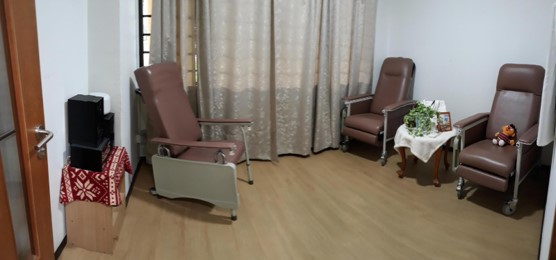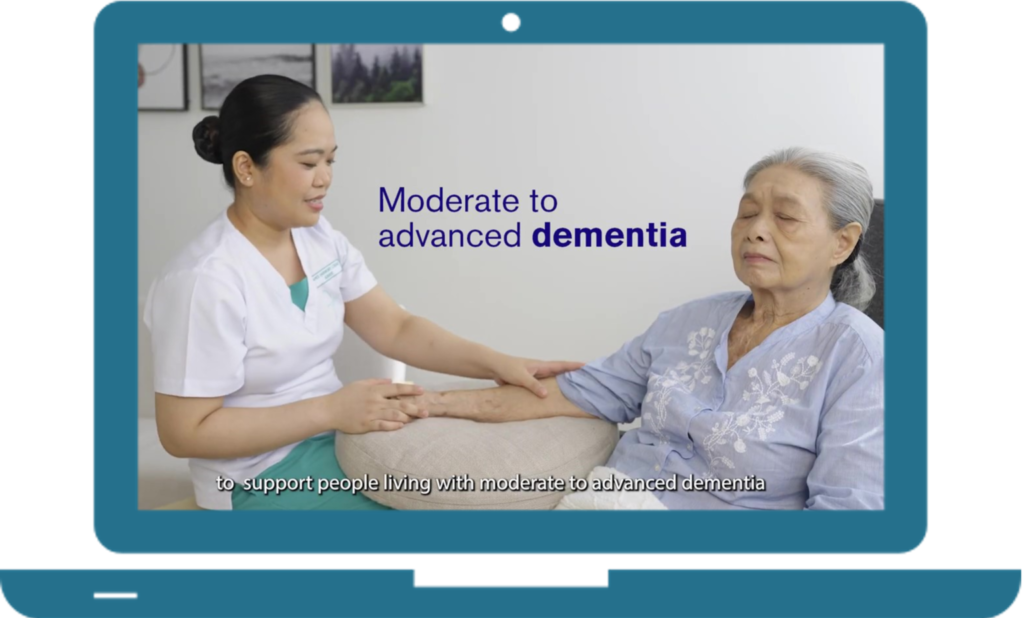Playback speed:
Nature & Background
Namaste Care programme is a structured intervention for persons living with advanced dementia, which incorporates sensory intervention, social contact and environmental modification. It aims to respect the individual person for his or her unique personhood, nurture the individual spirit with meaningful activities using a loving touch approach, within a calm and home-like environment.
Namaste Care Programme was initiated by Joyce Simard in the USA in 2003. A qualified social worker working in care homes in the USA, Joyce Simard attended to symptoms of persons living with advanced dementia and started to concentrate on their needs beyond medical concerns. She was inspired by the meaning of the Hindu term “Namaste” which is “to honour the spirit within” to base her development work on the “social, emotional and psychological aspects” of persons living with advanced dementia.1
Namaste Care programme was developed for care home residents with advanced dementia who might not benefit from typical group activities.2 Namaste Care is a daily programme that runs for 2 hours both in the morning and afternoon.2 An example of possible activities in a Namaste Care session is provided by Magee et al.3 during a feasibility trial of a programme in a care home in Northern Ireland with frequency of once-daily for 5 days a week over a span of 4 weeks.
“Seeing is Believing”, a 4-min video by Association for Dementia Studies, UK provides a good illustration of how Namaste Care is carried out, including benefits to persons at the advanced stage of dementia.
Source: Association for Dementia Studies at the University of Worcester
The original intention of Namaste Care targeted a small group of people living with advanced dementia in a residential setting. It has since been trialled in different settings including:
- Namaste Care Family programme in 10 Dutch nursing homes involving volunteers and family caregivers4,5
- Acute hospital setting in UK by activity coordinators,6 and tertiary hospital setting in Singapore by nurses7
- At individual home facilitated by volunteers via one-to-one session offered by community hospice in UK8
Namaste Care Intervention UK guidance documents serve to support Namaste Care workers running Namaste Care sessions in care homes in the UK.1 The guide discussed the specifics of setup and conducting Namaste Care sessions, supported by evidence-based literature and practical experience shared by care staff and family caregivers of 6 case-study care homes in the UK. According to the guide, Namaste Care can be extended to other residents in care homes including:
• Persons living with dementia at different stages of dementia with complex needs due to mental health issues, learning disability or resulting from behavioural and psychological symptoms of dementia.
• Other residents without dementia during periods of ill-health for a short time.
Principles & Core Elements of Namaste Care
The Goal of Namaste Care is to “honour the spirits within” the persons living with advanced dementia.9 Two Principles defining the practice of Namaste Care according to Manzar & Volicer,10 delivered via a one-to-one approach with consistent care staff are:
1. Comfortable environment which promotes:
a. Sense of calm
b. Small group setting and family-like
c. Meaningful verbal and non-verbal communication
2. Loving Touch focusing on:
a. Massage of hands and feet, hair and nail care
The relationship between the principles of Namaste Care and the effects on residents, staff and family are reflected in the diagram below:

(Volicer, 2019)
The foundation of Namaste Care is consistent with Person-Centred Care principles to meet needs of individuals living with advanced dementia.11 Kitwood’s identified psychological needs of persons living with dementia could be matched to core elements of Namaste Care2 as given below:

According to Stacpoole et al.12, core elements of Namaste Care include the guiding principle of respectful and compassionate approach towards persons living with advanced dementia and the following crucial components:
- Presence of others in a social group
- Comfort and pain management
- Sensory stimulation of the 5 senses
- Meaningful activities via personal care
- Life story knowledge of individual
- Food treats and hydration during session
- Care worker education and support
- Family meetings and involvement
- Care of the dying and after-death care
- After-death reflection by care staff
More information on the core elements can be found in Toolkit for implementing the Namaste Care programme for people with advanced dementia living in care homes developed by St Christopher’s Hospice, London.12
Benefits & Challenges
Few studies have found that Namaste Care resulted in decreased pain, more interaction between service users with staff and family members, and increased job satisfaction with staff.10
Persons living with Advanced dementia
1. Better quality of life with reduced experience of behavioural symptoms, pain and occupational disruptiveness;
2. Greater awareness and engagement in the environment; and
3. Given less medications.11,13,14
Care staff
1. Increase in confidence and self-esteem in providing care;
2. Better teamwork and greater job satisfaction; and
3. Practice of person-centred approach in care delivery.2,10,14
Relatives & Family Members
1. Fostered closer relationships with loved ones;
2. Improved communication with care home staff; and
3. Better visiting experience in care home.2,10,14
Namaste Care can enhance the Quality of Life of persons living with advanced dementia in care homes with existing “strong leadership” and “adequate staffing”; including quality nursing and medical care support.6, 11
According to Simard15, implementation of a successful Namaste Care programme requires “flexibility” and “creativity” of staff to tailor the programme to meet different needs and requirements in different nursing home settings. Continual ground experience and regular practice of Namaste Care principles through application of techniques help staff to stay relevant and improve in delivery of Namaste Care.15
Challenges on smooth implementation of Namaste Care resulted from the following factors:
- Unpredictable management support or considerable organizational changes14
- Lack of adequate clinical support14
- Collaboration between nursing and medical support11
There is limited scientific evidence on significant findings of application of Namaste Care approach,16 and effectiveness of Namaste Care activities8,17 for the following reasons:
- Small-scale studies or use of small sample sizes
- Lack of qualitative study on impact of Namaste Care on residents, staff and family caregivers in long-term care facilities within and outside USA
- Lack of quality research and review on a well-defined format in running a Namaste Care session using a clear recommended set of activities.
More RCT and review in evidence-based literature are needed to conclude and guide care staff or family caregivers to tailor Namaste Care sessions to persons living with advanced dementia in different care settings whether in centre- or home-based environment. Consistency in the delivery of Namaste Care programmes in different settings is an important consideration relating to the recommended daily frequency of at least 4 hours. Daily Namaste Care sessions appeared to have lasting effects on behavioural symptoms and meaningful activities for persons living with advanced dementia in long-term care facilities as compared with shorter and less regular programmes like Snoezelen Therapy, Multisensory and Motor Based Group Activity Programme, and Garden Experience.9
Guidelines for Implementing Namaste Care
1. A Sample Session Plan For Namaste Care in Dementia Day Care Centre
A suggestion on how a 1-hour Namaste Care session can be provided in a dementia day care environment:1,12
a. Greet individual with his or her preferred name and welcome into the Namaste room or a private space
b. Enable the individual to feel comfortable when seated, use blanket/ pillows/ towels where appropriate
c. Provide a warm towel to wipe hands
d. Offer a warm drink or sips of drink when individual is settled in the seat
e. Introduce meaningful activities involving gentle stimulation of different senses during the session
- Hand, scalp and/or foot massages as tolerated by the individual
- Tea break with snacks and drink
f. Towards end of session, prepare the individual for next part of the day, e.g. activities to energize or continue with relaxation
- Alerting with music and gentle movements in upper and/or lower limbs
- Grooming before leaving eg hair combing, brushing and styling
- Getting ready to leave
g. Thank the individual and say goodbye individually to all participants
2. List of Equipment/ Materials Needed for Namaste Care
(Reference: St Christopher’s toolkit12)
Essential equipment and supplies (most might already be available in the day facility or nursing home):
- Comfortable chairs
- Music system and CDs (or MP3 player and downloads)
- An aromatherapy diffuser (or a plastic spray bottle with distilled water and a drop of lavender essential oil)
- Attractive coloured rug/blanket for each individual
- A ‘wash bag’, or zip locked bag for each individual containing his or her own brush and comb, face cream and hand cream, nail clippers, emery board, lip balm, etc.
- Drinking cups that can be labelled, or disposable cups and a marker pen
- Face cloths and towels
- A large storage bag for each individual, e.g. a plastic zip bag to keep a rug and/or pillow and perhaps a life-like doll or animal, as preferred by the individual
- A rummage bag with scraps of different textured material, bubble wrap, etc.
- Two to three portable (preferably folding) chairs for the Namaste Care worker and for visitors
- Hand sanitizer, rubbish bags
- Box of tissues for runny noses
- Laundry bags and gloves in case of accidents
- Namaste Care worker has a visible name badge with their first name in large font
- Welcome sign (one care home has a notice: ‘Please come in quietly and gently’)
- A trolley for transportation of equipment for the session
Collect and use individual client’s own supplies (discuss this with family/loved ones):
General Supplies
• Pillows for positioning
• Blankets/rugs/quilts (colourful)
• Face cloths
• Bowls in which to soak hands
• Towels
• Aqueous cream for moisturising skin
• Cotton buds
• Hypoallergenic oil for massage
• Soap dispenser/hand sanitiser
• Gloves and laundry bags in case of accidents
• Disposable wipes
Personal Supplies for Namaste Client
A clearly named bag containing:
• Hairbrush and comb
• Nail clippers
• Emery board
• Face cream
• Lip balm
• Items supplied by the family, e.g. perfume and makeup for women, after shave for men
A large bag such as a dry-cleaning bag to keep the blanket and, for example, a life-like animal, which is preferred by the individual.
Recommended additional list for Namaste equipment (may be available in the day facility or nursing home, or via donation or other available funding):
• Green plants
• One or two life-like dolls
• Life-like cats and dogs
• Life-like singing birds
• A fridge for food treats
• Picture books
• Poetry books
• A variety of essential oils
• Tambourine and rainmaker
• Pictures and ornaments
• A DVD player and appropriate films with a screen to show them
• Foot spa

A private room for Namaste sessions.
Courtesy of Dementia Singapore’s New Horizon Centre at Toa Payoh.
An example of a “perfect” Namaste room:
Ideally, Namaste Care has a designated room with the following considerations:
- Everything can be left in place
- Supplies can be locked after session and
- More active clients can enter the room for sensory exploration with growing plants or fragile ornaments
A Namaste space can be created if there is no designated room to be used. A quiet corner or an area in a suitable environment with minimal distraction can be screened-off.
The environment should be made ‘special’, i.e. welcoming and homely, with natural or slightly dimmed lighting, appropriate décor with attractive scents, and with soft music playing in the background.
In the “perfect” Namaste room, there will be:
- A window looking over a garden
- A door to the outside
- A DVD player and appropriate DVDs
- Reclining chairs
- Ornaments from the past
- A fridge
- A smoothie maker
- A music system with a variety of music
- An aromatherapy diffuser
- Beautiful pictures
- Growing plants
- A cupboard to keep items and can be locked
- A sink with running water
- Curtains or blinds
Namaste Care Trainings
Finally, after reading the sections above and understanding the underlying mechanisms for an impactful Namaste Care Programme, it’s time to put them into practice!
For Caregivers (Basic)
In collaboration with the Agency for Integrated Care (AIC), Apex Harmony Lodge (AHL) has developed a module to:
1. Equip caregivers with the knowledge on Namaste Care principles
2. Equip caregivers with the skills to confidently provide Namaste Care in the form of a gentle hand massage
3. Help caregivers to connect with their clients/loved one
Learn how to provide Namaste Care in the form of a gentle hand massage

Log in via SingPass.
Click on “Express your interest”. You can then locate the course in your Dashboard.
If you do not have access to LMS, contact your COO LMS administrator.
At AHL, Namaste Care has been adopted for residents in the Supported Living and Tender Loving Care Homes. Specifically, the programme supports the residents by meeting their sensory and emotional aspirations through the loving provision of personalized and sensory stimulating activities within a tranquil environment.
Read how residents at AHL have benefitted immensely from Namaste Care, such as reduced rejection of care, improved mood, appetite, and engagement!
Find out more about Namaste Care here. If you’ve any questions, please email the Agency for Integrated Care at [email protected].
For Care Professionals (Intermediate)
Dementia Singapore Academy also offers a Namaste Care course for healthcare professionals. This blended course aims to provide learners with theoretical and practical knowledge of delivering Namaste Care as a specialised intervention for persons living with dementia in their settings.
Find out more here.
Acknowledgment
Some content in this article was adapted from the training notes compiled by Institute of Geriatrics and Active Ageing (IGA) for Namaste Care Workshop by Dr Noorhazlina Bte Ali on 16 and 23 Nov 2019.
Tell us how we can improve?
- Jacobson-Wright, N., Latham, I., & Frost, F. (2019). Guidance for Care Homes-Implementing Namaste. University of Worcester: Association for Dementia Studies. https://www.worcester.ac.uk/documents/Guidance-for-Care-Homes-V3-updated.pdf
- Stacpoole, M., Hockley, J., Thompsell, A., Simard, J., & Volicer, L. (2017). Implementing the Namaste Care Program for residents with advanced dementia: Exploring the perceptions of families and staff in UK care homes. Annals of Palliative Medicine, 6(4), 327-339. doi: 21037/apm.2017.06.26.
- Magee, M., McCorkell, G., Guille, S., & Coates, V. (2017). Feasibility of the Namaste Care Programme to enhance care for those with advanced dementia. International Journal of Palliative Nursing, 23(8), 368-376. doi: 10.12968/ijpn.2017.23.8.368.
- Smaling, H., Joling, K. J., van de Ven, P. M., Bosmans, J. E., Simard, J., Volicer, L., Achterberg, W. P., Francke, A. L., & van der Steen, J. T. (2018). Effects of the Namaste Care family programme on quality of life of nursing home residents with advanced dementia and on family caregiving experiences: Study protocol of a cluster-randomised controlled trial. BMJ open, 8(10), e025411. https://doi.org/10.1136/bmjopen-2018-025411
- Steen, J. T. V. D., Joling, K. J., Francke, A. L., Achterberg, W. P., & Smaling, H. J. (2019). The effects of the Namaste Care family program on quality of life of people with advanced dementia. Innovation in Aging, 3(Supplement_1), S824-S824.
- St John, K., & Koffman, J. (2017). Introducing Namaste Care to the hospital environment: A pilot study. Annals of Palliative Medicine, 6(4), 354-364. doi: 10.21037/apm.2017.06.27.
- Ali, N., Tan, C. N., Kang, J., Chew, A. P., Caroline, C., & Lim, W. S. (2019). Namaste care program for advanced dementia: Impact on persons with advanced dementia (PWAD), caregivers and healthcare staff. Alzheimer’s & Dementia: The Journal of the Alzheimer’s Association, 15(7), 1446-1447.
- Dalkin, S. M., Lhussier, M., Kendall, N., Atkinson, J., & Tolman, S. (2020). Namaste care in the home setting: Developing initial realist explanatory theories and uncovering unintended outcomes. BMJ Open, 10(1), e033046. doi: 10.1136/bmjopen-2019-033046.
- Volicer, L. (2019). Review of programs for persons facing death with dementia. Healthcare, 7(2), 1-12. doi: 10.3390/healthcare7020062.
- Manzar, B., & Volicer, L. (2015). Effects of namaste care: pilot study. American Journal of Alzheimer’s Disease, 2(1), 24-37. doi: 7726/ajad.2015.1003.
- Stacpoole, M., Hockley, J., Thompsell, A., Simard, J., & Volicer, L. (2015). The Namaste Care programme can reduce behavioural symptoms in care home residents with advanced dementia. International Journal of Geriatric Psychiatry, 30(7), 702-709. doi: 1002/gps.4211.
- Stacpoole, M., Thompsell, A., & Hockley, J. (2016). Toolkit for implementing the Namaste Care programme for people with advanced dementia living in care homes. St Christopher’s. https://www.stchristophers.org.uk/wp-content/uploads/2016/03/Namaste-Care-Programme-Toolkit-06.04.2016.pdf
- Simard, J., & Volicer, L. (2010). Effects of Namaste Care on residents who do not benefit from usual activities. American Journal of Alzheimer’s Disease & Other Dementias, 25(1), 46-50. doi: 10.1177/1533317509333258.
- Thompsell, A., Stacpoole, M., & Hockley, J. (2014). Namaste care: The benefits and the challenges. Journal of Dementia Care, 22(2), 28-30.
- Simard, J. (2019). Back to the bedside. Caring for the Ages, 20(7), 9.
- McNiel, P., & Westphal, J. (2018). Namaste Care™: A person-centered care approach for Alzheimer’s and advanced dementia. Western Journal of Nursing Research, 40(1), 37-51. doi: 10.1177/0193945916679631.
- Bray, J., Brooker, D. J., & Garabedian, C. (2019). What is the evidence for the activities of Namaste Care?: A rapid assessment review. Dementia, 147130121987829. doi: 10.1177/1471301219878299.





